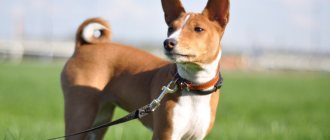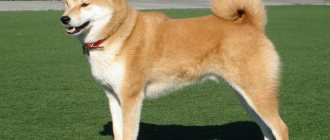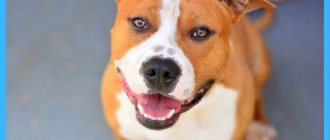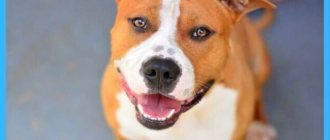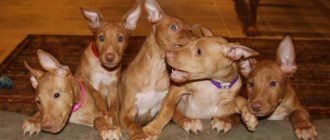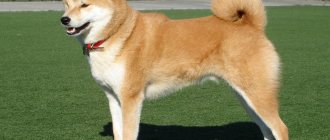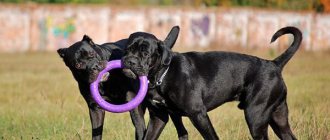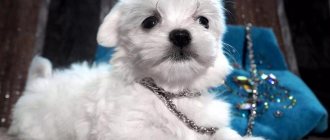The Shiba Inu is a truly amazing hunting dog of Japanese blood. Translated from Japanese, the word “Shibu” means small, and “Inu” means dog. The wayward breed, similar in appearance to a fox and its larger brother Akita Inu, known throughout the world from the film Hachiko, has a reddish-white coat color, an elongated muzzle, cunning squinting eyes and pointed ears.
Considered one of the most ancient dog breeds , in the past they were used to hunt small animals and birds. When united in a pack, inus are able to compete even with a deer or bear.
Keeping a Shiba Inu at home
The conditions of an apartment are absolutely not suitable for keeping a Shiba Inu, but a country house with a large plot of land is what this animal needs. This is a physically developed breed, so you will have to take it on daily long walks, taxing the dog physically. If we talk about a regular walk on the site, which is suitable for other breeds of dogs, then it is not suitable for the Shiba Inu. Long runs or even bike rides are ideal for your pet.
Despite the fact that the Shiba Inu is not a large breed, it needs space, so a city apartment will be quite cramped for the animal. The breed has well-developed hunting and guarding instincts, so they become very attached to their territory. This fact indicates that a better watchman could hardly be found.
Naturally, the appearance of the animal is unlikely to scare away uninvited guests, but it will make a lot of noise, although the dog never barks unnecessarily. It is also necessary to take into account the fact that a dog can easily mistake smaller dogs, and even more so cats, for hunting.
In this case, it is very important to choose the time for walks in such a way as to minimize encounters with other animals. As a rule, this is typical for young dogs that have not yet been fully trained.
Care and hygiene
This breed is considered quite clean, because while on a walk the animal avoids puddles and generally tries not to get dirty. It is not necessary to wash them after a walk, but you will still have to clean them with a special brush. In addition, dogs lick themselves without any problems.
What to feed
Since the dog is active, cheerful and strong, its diet must contain all the components that could provide it with such active behavior. You can save yourself the hassle of organizing meals by using premium ready-made food. There are no special foods for feeding this breed, so it is acceptable to use any food intended for feeding medium- and small-sized dogs. This does not mean at all that you cannot feed your dog natural products. As a result of this choice, you will have to stand at the stove to prepare various porridges in meat broth for your pet. In this case, you can give lean meat, as well as offal, but not often.
Once a month, lean fish and vegetables should be included in the diet. Vitamin supplements in the form of dry seaweed will also not hurt. Young dogs need to be fed 4 to 6 times a day, while older pets need to be fed only a couple of times a day. This feeding regimen will allow the animal to maintain good physical shape for many years.
It is necessary to control that the dog does not overeat, which can cause obesity and, as a result, the appearance of a number of ailments. It is possible that some types of food may cause allergic reactions. In this case, the food will have to be changed. In dogs over 10 years of age, their teeth wear out and weaken, so it is preferable to feed them wet food.
Diseases, breed defects
The Shiba Inu breed belongs to the category of dogs with high immunity, although they may exhibit some hereditary ailments. Experts are currently working on this problem. The first group of ailments includes joint dysplasia, patella dislocations and hypothyroidism. This group of diseases can be caused by obesity, which is associated with additional stress on all types of joints.
Therefore, the process of feeding a pet should be approached with great responsibility, since its health depends on it. The second group of diseases includes vision problems. These are cataracts and entropion. If such a problem occurs, you should immediately contact a specialist. The third group includes diseases associated with allergic manifestations to individual nutritional components, as well as to hair care products
If such problems occur, you should immediately pay attention to the quality of food and its components. It should be noted that such problems are much less common in the Shiba Inu breed compared to other purebred dogs.
About keeping a Shiba Inu
Watch this video on YouTube
Dry or natural food, which is better?
Both ways of eating have their pros and cons.
Dry food already contains all the necessary substances . In addition, it is much cheaper and easier to feed your dog with it. The owner does not need to select food and cook every day. The main disadvantage of dry food is preservatives and other harmful additives.
Natural nutrition is more natural. Meat, fish, and vegetables give the dog everything he needs for a healthy life and does not contain harmful components .
Features of maintenance and care
The Shiba Inu is suitable for both indoor and outdoor living. Dogs live well in a yard or in an enclosure if they have a warm kennel. But the area must be surrounded by a high fence, otherwise the curious dog will run away.
When kept in apartments, pets are provided with daily walking. Well-mannered Shiba Inu behave quite quietly and do not bark unless necessary.
Grooming
Caring for representatives of the breed is not difficult, but you need to know some features. Shiba Inu grooming consists of:
- periodic washing;
- combing the fur coat;
- eye, ear and oral hygiene;
- trimming nails if necessary.
A massage brush with medium-hard bristles is suitable for brushing a Shiba dog. During molting, a slicker is used. The animal's fur is pre-moistened with conditioner.
Representatives of the breed are usually not cut so as not to disturb their natural appearance. You can only remove the hair between the paw pads to prevent the dog from slipping on smooth surfaces. Before the exhibition, it is advisable to have your Shiba Inu professionally groomed.
Shiba Inu is bathed a couple of times a year or when dirty. However, it is not recommended to do this too often - the wool will lose its natural protective sheath. It is very difficult to get your pet's fur wet due to the thick undercoat. The animal is watered for a long time from the shower, directing the stream of water against the growth of the fur.
It is recommended to purchase special cosmetics for washing dogs - human shampoos disrupt the natural structure of the fur. After bathing, the pet is thoroughly dried with a towel. It is not advisable to use a hairdryer - hot air dries out the animal’s skin greatly.
Shiba Inu grooming also involves the following procedures:
- 1-2 times a week – cleaning the ears and eyes with a cotton swab;
- every 3-4 days – brushing teeth with veterinary paste and a special brush;
- 1-2 times a month - trimming nails, if the dog does not grind them down on asphalt or other hard surfaces.
Walk
When keeping a Shiba Inu in an apartment, pets are walked twice a day for at least 40 minutes. If the dog lives in an enclosure, then it is better to spend more time communicating and playing together.
During the walk, animals must be kept on a leash. Having smelled an interesting smell, the dog stops seeing and hearing those around him. The pet can only be released in a fenced area or a special area.
Feeding
Shiba Inu is given ready-made premium or super-premium food or natural food. In the latter case, the basis of the dog’s diet is lean meat and high-quality offal – up to 50%. The animal menu also includes:
- sea fish;
- porridge;
- vegetables;
- fresh herbs;
- dairy products.
Animals are strictly contraindicated:
- pork;
- spicy, salty, pickled or smoked foods;
- bakery and confectionery products.
Nutrition
Owners know that the breed is very independent and prone to bouts of “activity.” Dogs that do not receive adequate nutrition may become lethargic and anxious due to lack of nutrients. The right food supports their brain and motor functions.
What to feed your Shiba Inu?
Be careful about how much and what you feed your Great Dane.
The main necessary substances for the breed:
- Protein. It contains amino acids that are essential for creating healthy muscles, tissues and cells. Protein, found in proteins, helps with development during puppyhood and adulthood. The ideal source of protein for the species is whole animal meat.
- Fiber is needed for two main purposes. It helps produce the energy needed to stay active and also promotes a healthy digestive system.
- Carbohydrates. They are a source of quick energy. Large amounts of carbohydrates can be harmful to your pet. High-quality dog food formulas already take care of the ratio of protein to fat and carbohydrates. Therefore, you just need to make sure that you follow the feeding instructions.
- Omega 3 and 6 fatty acids and vitamins. They are important components that contribute to the health of your pet's skin and coat. The coat will shine when the dog gets enough Omega 3 and 6.
- Fat. It is needed to process nutrients and produce hormones. Contrary to popular belief, fat does not cause weight gain. Rather, it helps provide sustained energy so your pup can enjoy walks and play without becoming prematurely tired. If you notice that your friend is showing signs of lethargy, he may not be getting enough fat or other nutrients in his diet. Discuss these symptoms with your veterinarian.
How much to feed your Shiba Inu?
All dogs have approximately the same nutritional needs. However, there are differences in energy needs depending on the age, gender and activity level of your pet.
The easiest way to determine how much to feed your pet is to follow the recommendations on the food package. The problem is that these recommendations may not take into account your pet's activity level. If you want to be more precise, you can calculate his actual calorie needs.
The average energy requirement for an adult is about 30 calories per 0.45 kilogram.
Keep in mind that small pets have a very fast metabolism, while larger pets have a slower one. The Inu falls into the first of these categories, having a maximum weight of about 11 kilograms. Animals this size typically require more calories because their daily energy expenditure is higher. Therefore, they need 35 or 40 calories per 0.45 kilograms. This gives a range of 595 to 1000 calories per day, depending on the size of the individual.
Usually the animal eats well. But if your dog refuses to eat for a day or more, contact your veterinarian immediately.
How it develops day by day in the first month
| Age (days) | Baby development |
| 1-5 | At this age, the puppy is completely dependent on its mother. All he can do is suck, squeak and crawl around. A newborn puppy lacks vision, hearing and thermoregulation. |
| 6-8 | During this period, the pet is actively gaining weight. By the end of the first week, the dog weighs approximately 2 times more. |
| 9-10 | In the second week of life, the baby not only increases in weight, but also in strength. Now you can easily identify stronger and weaker individuals. |
| 15 | Starting from this period, the puppy's eyes gradually open. He reacts to light, but does not yet know how to navigate in space. The baby begins to develop its own thermoregulation, vision and hearing. Dependence on the mother becomes less. |
| 16-18 | The puppy already sees and hears well. |
| 19-22 | The first teeth are erupting. |
| 23-24 | Interest in solid food appears, the puppy learns to bite and chew. During this period, he begins the first stage of socialization. |
| 25-30 | The puppy is much less dependent on its mother, eats solid food, shows interest in its surroundings, and actively plays with its brothers and sisters. |
Main types of colors
Red
Red color means a deep red or bright red hue.
This color is one of the most common among Shiba Inu. According to the breed standard, this color should be bright, saturated, but without turning into brick.
As for weak shades of red, they receive lower ratings at exhibitions, but are still not considered a defect.
Sashige
The color of sashige is red interspersed with black hairs (not to be confused with sesame). This color is also called dirty red.
The basis here can be absolutely any shade of red, which seems to be sprinkled with black hairs on top. According to the standards, it belongs to the red colors.
Black and Tan
This type of color is considered complex, as it includes several colors:
- Black.
- Red (various intensity).
- Brown.
- White and ashen.
With this color, the undercoat is usually white or ashy. In this case, the lower part of the muzzle, paws, belly and neck are painted in lighter colors, usually red, white, beige or ash.
Sesame
There are several varieties of sesame color. In most cases, the base color is red with the addition of black hairs. The base can also be light red, beige or ashy.
There is also black sesame, when the amount of black wax predominates over the base color.
All colors must have a “urozhiro” effect - light shades on the cheekbones, chest, belly, lower jaw, inside of the paws and under the tail.
Otherwise, the dog will not be allowed to participate in the exhibition.
Special character
The Shiba Inu dog has a wayward character. She is affectionate and playful towards children, but at the same time calm and self-sufficient.
Yes, dogs are active, especially when walking, but they do not show any desire to cuddle with their owner all day long. Since the breed was originally bred for hunting, the dogs were accustomed to being alone.
Even young Shiba Inus protect their territory and owner, because they are very brave, and when they grow up, they make excellent guards.
Early socialization is very important for representatives of the breed - the more the dog is taken out into the world, the more sociable and obedient it will be.
Characteristic
Shiba Inu is a primitive breed of dog, previously used for hunting, belongs to the fifth group of the breed classification. Today it is increasingly being purchased as a companion. Operational tests are not carried out.
FCI breed standard: No. 257
The Shiba is a small, compact dog, balanced, with well-developed muscles. She moves easily and freely.
The Shiba Inu has a flat forehead, which runs distinctly into a nose with a straight back, tapering to a black nose. The muzzle is of moderate thickness, tapering only near the lobe. Tight lips cover strong jaws that meet in a scissor bite. The cheekbones are well defined and the muzzle looks full.
Triangular dark brown eyes are set straight, the outer corners are slightly raised. The ears are triangular, small, located at the top of the skull - the tips are rounded, and the ears themselves look forward. The neck is strong and muscular, in proportion to the body. The back is muscular, the lower back is wide, the stomach is tucked, and the chest, on the contrary, is deep. The thick tail is set high, the dog keeps it tightly curled into a ring, less often - unfolded into a sickle.
The limbs are straight and thick, quite long, with developed muscles. The fingers are collected and curved.
The most critical defects:
- cowardice;
- aggression;
- “loose” or floppy ears;
- hanging tail.
Shiba Inu breed: description of character and appearance, history of the breed
Dimensions, weight and height of the breed
Standard Shiba Inu sizes:
- females – about 37 cm;
- males - about 40 cm.
According to breeders, the weight of dogs ranges from 9-14 kg.
Possible colors
The coat of Shiba Inu dogs is thick, with a good soft undercoat that raises the guard hairs. On the tail the hair is longer and stands upright.
Possible colors:
- red;
- sesame – black, red or regular.
The usual sesame color is otherwise called sesame - it is a combination of white and black hair in equal quantities. Black sesame - the same combination, but with a predominant amount of black hair. Red sesame is a red color interspersed with black hair.
With any color, the urajiro effect is required - the presence of light hairs on the face.
Puppy weight by month
Shiba Inu puppies develop in leaps and bounds and at the age of eight months almost reach their maximum adult weight. Breeders do not provide data on the relationship between weight and age, but you can monitor the puppy’s fatness by feeling its sides in the area of the last two ribs. If the ribs can be felt well, but do not stick out, it means that you are feeding the dog correctly and it is developing normally.
Lifespan
The life expectancy of a Shiba is 12-13 years, but there are cases when companions lived up to 15-16 years, remaining active and vigorous in old age. To increase life expectancy, regularly maintain your pet's health and fitness.
Allergenicity
Shiba Inus do not emit a dog odor, but they shed a lot, which is why they can hardly be called hypoallergenic. Before purchasing a puppy, make sure there is no reaction by visiting an allergist and taking a PAST test.
Shiba Inu breed: description of character and appearance
Development from 1 to 12 months
The table below shows how the average size of a Shiba Inu changes as the puppy grows.
| Age in months | Size | Weight | Description |
| 1 | 10-14 | 400-600 g | In the first two weeks after birth, the puppy is completely helpless. After the second week of life, the baby can already see and hear. And by the end of the first month, he eats independently and masters the world around him. |
| 2 | 16-18 | 2.3-3 kg | The baby is getting teeth, he is actively growing and socializing. During this period, the puppy is taken away from its mother. |
| 3 | 18-22 | 3-4 kg | Socialization and growth continues. At this age, leaders begin to emerge. |
| 4 | 22-25 | 4.5-5.5 kg | The puppy enters adolescence, baby teeth are replaced by permanent teeth, and the formation of its own immune system occurs. |
| 5-6 | 26-30 | 5.6-8.7 kg | The second stage of socialization, at this age dogs often fight for primacy and leadership. The reason is entering the puberty phase. |
| 7-9 | 27-33 | 9-15 kg | Bitches begin their first heats and growth slows down. The dog does not gain weight so quickly and becomes like an adult dog. |
| 10-12 | 30-35 | 15-25 kg | The end of puberty and character formation. Now she is a young adult dog. |
Nicknames
For boy
Popular Japanese boy names with meaning:
- Akira - bright.
- Daiki - great glory, nobility.
- Haruki is the shining sun.
- Hinata is a sunflower, facing the sun.
- Hiro is generous.
- Ichiro is the first son.
- Itsuki - forest trees.
- Jiro is the second son.
- Kichiro is a happy son.
- Kiyoshi – purity.
- Kuta is a great world.
- Masaki is a big tree.
- Masato is a righteous man.
- Masumi – true clarity.
- Nao - honestly.
- Nori - edit.
- Osamu – disciplined, diligent.
- Riku is earth.
- Shinobu – endurance.
- Takahiro – valuable, noble.
- Takashi is prosperous.
- Toshi is wise.
- Yasushi – peaceful.
For girl
Popular Japanese nicknames for girls with meaning:
- Akemi is a bright beauty.
- Asami - morning beauty.
- Haru - spring.
- Hideko is a child of perfection.
- Hikari – light, radiance.
- Hiro is generous.
- Hiroko is a generous child.
- Hoshi is a star.
- Kimi is noble.
- Kiyomi is pure beauty.
- May - dance.
- Maiko is a child of dance.
- Maki is true hope.
- Mika is a wonderful scent.
- Miku is a beautiful sky.
- Mio is a beautiful cherry color.
- Misaki is a beautiful flower.
- Natsuki is the summer hope.
- "Peekaboo" is a women's hairstyle.
- Rio - Sakura Village.
- Satoko is a wise child.
- Shinju is a gem.
- Shiori is a poem.
- Sora is the sky.
- Yoshi is a lucky guy.
- "Foxy" is a fox.
- Yuki is happiness.
History of the breed
Genetic studies confirm that the Shiba Inu is one of the oldest Asian breeds and dogs similar to it were found in the territory of modern Japan more than three thousand years ago, and ceramic figurines found by archaeologists serve as evidence that in the 3rd century BC they arrived in Japan Korean settlers who brought dogs with pointed ears and ring tails. The modern appearance of the Shiba Inu is the result of crossing native dogs with newly arrived ones.
In 1862, after the opening of the Land of the Rising Sun to foreigners, the crossbreeding of indigenous Japanese breeds with foreign ones began, of which many were imported between 1868 and 1912, in particular dogs of Western breeds, including English setters and pointers. By 1926, mating with imported breeds brought the Shiba, as well as other native breeds of Japan, to the brink of extinction.
In 1928, with the support of the Japanese government, a society for the preservation of indigenous Japanese breeds was founded - Nippo (Japanese: 日本犬保存会nihonken hozonkai
), and the Ministry of Education has classified local dogs as natural monuments.
Thanks to the painstaking work of selecting purebred dogs of Japanese origin, a temporary herd was created using different types of dogs from the provinces of Mikawa and Sanshu, all of them differing in size, color and body features. Among them, a group of small individuals was selected and called Shiba Inu.
Breeding dogs belonged to three main types and had small erect ears, deep-set triangular-shaped eyes and a tail curled steeply over the back:
- Shinshu-shiba (Japanese: 信州柴犬) from Nagano Prefecture often had a red color, a soft undercoat and a rough, needle-like spine;
- Mino-shiba (Japanese: 美濃市柴犬) from Gifu Prefecture had a dark red color;
- The San'in Shiba (Japanese: 山陰地方柴犬) from northwestern Japan is a spotted black and white dog, larger than the Shiba.
Cladogram of ancient dog breeds
The work done made it possible to approve the breed standard already in 1934, and two years later the Shiba Inu was declared a national treasure, which played an important role in its further development. That same year, along with the Akita Inu, the Kai and the later extinct Koshi No, the Shiba Inu was recognized as a breed.
The Second World War threatened the existence of the Shiba Inu, almost nullifying the efforts of Japanese canine enthusiasts, and only in 1948, with the support of Nippo, the surviving dogs of different lines were collected for restoration, which made it possible to save the breed from extinction.
At home, three main organizations are involved in breeding Shiba Inu - “Nippo”; , founded in 1949; and "Sibaho" (1959). They maintain their own stud books and issue pedigrees of different samples. The accepted standards of the first two recognize red, black and tan and sesame colors, while Sibaho also recognizes white Shibu.
The breed is recognized by , , , , , , , .
In its homeland, where about 30 thousand dogs are registered annually, and up to 700 or more are collected at a specialized exhibition, the breed is one of the most popular; of the registered representatives of indigenous Japanese breeds, Shiba Inu accounts for 80%. One of the issues of the monthly Japanese publication on cynology is regularly dedicated to the Shiba Inu; it can be found both in the center of the capital and in the provinces. In addition, there is information about the existence of an unspecified form of dwarf shiba with a height of 19 to 30 cm.
Jomon-shiba
The Fédération Cynologique Internationale recognized the breed in 1964. For the first time in Europe, the Shiba was shown in 1969 at an exhibition in Denmark. In the 1970s, some European nurseries began breeding. In 1987 it came to Great Britain, where in 1992 it was first demonstrated at the Crufts and was recognized as a breed by conservative Englishmen.
In the United States, the Shiba was ranked the 44th most popular breed in 2022, and is also common in Australia and Europe. The Shiba Inu was brought to Russia at the very end of the twentieth century.
There is a variety of Shiba Inu - Jomon Shiba - which is more fit and lean, differing in the structure of the skull and the size of the teeth.
Varieties
In fact, modern Shibas appeared by crossing three varieties of breeding dogs selected by specialists. The table describes the characteristics and region of residence of the animals, thanks to which the rare Japanese breed was restored in the post-war period.
Table - Varieties of parent dogs of modern Shiba Inu
| Species name | Region of residence | External features |
| Shinshu-shiba | Nagano | — Red color; - spiny spine; - delicate undercoat |
| Mino-shiba | Gifu | Brick wool color |
| Sanin-shiba | North-west of the country | — Large size; - monochrome coat color |
As for the modern varieties of Shiba Inu, there is only one. Its name is written as “jomon-shiba”. This is a fit, taller dog, the shape of the skull and the structure of the teeth are visually different from the “cheeked” Shiba.
The Jomon Shiba is a breed that is popular among dog breeders and connoisseurs in Japan, but is practically not found outside its homeland.
History of the breed
Dog fighting has long been a traditional entertainment for the Japanese. Dogs were selected for them and underwent special training.
They were instilled with such qualities as calmness, endurance and organization. The battle usually went on until one of the opponents defeated the other.
People liked to watch the animals during these peculiar fights, although they believed that the local dogs did not have enough fighting agility.
However, in the middle of the 19th century, when Japan was already actively participating in trade with other countries, a new breed of dogs was brought to its territory.
Over time, it turned out that they have all the data for fighting, but they lack training. Then Japanese breeders were seriously puzzled by the question of whether it was possible to create a breed that would have all the necessary qualities.
So in 1868 the Tosa Inu appeared. The dog received this name from the area where it was first bred.
In 1924-1933, the breed was successfully raised by local farmers. After the Second World War, the Japanese mastiff, as the Tosa Inu was also called, was almost on the verge of extinction, as there was a period of famine in the country.
Then the situation in the state stabilized, and in 1976 the animals were exported to Europe, and later appeared in Russia.
Cynologists are still arguing about what breeds the Tosa Inu was bred from. There are versions that the breed was crossed with mastiffs, bulldogs or bull terriers. In general, many people notice the relationship between the Tosa Inu and the Neapolitan, Tibetan Mastiff and Bullmastiff.
Interesting Facts
- The breed is prohibited in a number of countries, including Denmark, Norway, and the UK.
- Tosa Inu has many names. One of them - tosa sumatori - means that in the ring representatives of this family behave like real sumo wrestlers.
- Tosa Inu is a rare breed not only in the world, but also in its homeland. Not every Japanese has seen a “samurai dog” with his own eyes at least once in his life.
- All Japanese mastiffs work proactively and make decisions independently in critical situations, anticipating the owner's command and attacking without warning barking.
- The easiest way to purchase a tosa token is in South Korea, Europe and the USA, and the most difficult is in Japan. However, it is the animals from the Land of the Rising Sun that are of the greatest value both in breeding and fighting terms.
- The breed is insensitive to pain, so it is better not to let the Tosa Inu get into fights with its fellow tribesmen in order to avoid injury.
- Representatives of the American line are an order of magnitude larger and heavier than their Japanese counterparts, since in the New World the breed is often used in weightpulling.
Tosa Inu is an energetic companion with an outstanding fighting background and an emphatically Japanese equanimity of character. There is only one way to make friends with this muscular handsome man - by convincing him of your own strength and superiority. If this succeeds, you can count on respect and the most devoted love that exists. However, the breed prefers not to talk about its real feelings for the owner and people in general, so emotions for show and servility are definitely not about Tosa Tokens.
About the Shiba Inu and Akita Inu kennel Iz Pushkino
Welcome to the website of the Shiba Inu and Akita Inu kennel from Pushkino.
Kennel Iz Pushkino specializes in breeding Akita Inu (Akita-inu) and Shiba-inu (Siba-inu, Shiba-inu) dogs.
If you are planning or just thinking about where to buy an Akita Inu or Shiba Inu puppy, then you have come to the right place.
These Japanese dog breeds are popular all over the world, and Russia is no exception.
So why is this dog breed so popular?
Akita Inu is a hunting dog of Japan. The dog got its name from the province of Akita, located in the northern part of the island of Honshu.
Akita is a very ancient breed, the skeletal remains of a primitive Spitz-type dog were discovered in Japan more than two thousand years BC.
The large broad-browed head, massive paws and unusually shaped pocket ears make the Akita look like a wolf, a fox and a bear at the same time. In general, this is a harmoniously built, strong dog of large size. Amazingly, all the beauty of the Akita was created solely by the forces of nature, with virtually no human intervention.
Akita Inu is a very special dog. The Japanese boldly entrust their children to her; for them she can become an excellent nanny. In general, this dog is very attached to its family and even to family friends. And high intelligence, courage and discipline make her a balanced, patient, but always ready to fight dog.
Shiba Inu (Shiba Inu) - translated from Japanese, Shiba means “small dog from the bush forest.” This reflects the purpose of the breed - hunting game birds in thickets with dense undergrowth.
Very often there is an erroneous name for this breed - Shiba. This mispronunciation of the breed's name was due to a poor translation of the English language standard. In accordance with Kiriji, the name of the breed “柴犬” is written in Russian letters as “Shibainu” or “Shibaken”. The ancestors of the Shiba were dogs that hunters used to hunt various game, crossing with each other in order to concentrate and consolidate the desired hunting qualities. The modern Shiba Inu (Shiba Inu) is the result of targeted breeding selection, which was carried out on the basis of three types of small Japanese dog breeds: San-in, Shin-shu and Mino.
The Shiba Inu is smaller in size than the Aktia Inu. The Shiba Inu is also perfect for living in the city. Here she often becomes a reliable guard, a zealous watchman.
By nature, the Shiba Inu is good-natured, quite intelligent - the Shiba quickly understands what is required of it. Shibs are very picky eaters and do not require a wide variety of food. Shiba is a very clean dog, she does not spoil things and will not relieve herself in the apartment, provided that she is walked regularly.
Shibas are very playful, but at the same time independent, for which they are sometimes called little samurai.
Now the Shiba is rarely used as a hunting dog, but as a companion dog, the Shiba Inu is increasingly gaining popularity both in Russia and abroad, not to mention the homeland of these dogs, Japan, where the Shiba Inu is considered a national treasure.
Our nursery has existed for more than 8 years. The nursery is officially registered in the RKF on 03/03/2005. During this time, many families have found true friends and companions in our nursery. Our Akitas and Sibs live in many cities of Russia: Moscow, Tula, Tver, Yaroslavl, Vladimir, Ivanovo, Sarovo, Ryazan, St. Petersburg, Kirov, Orenburg, Samara, Tyumen, Chelyabinsk, as well as in Kazakhstan and Ukraine. The goal that we have set for ourselves is to obtain Akita Inu and Shiba Inu puppies with a stable psyche and temperament that fully comply with the standards of the Shiba Inu and Akita Inu breed. Our nursery is located in Pushkino, Moscow region, 17 km from the Moscow Ring Road.
We attach great importance to the health of our puppies and producers. Our Shiba Inu and Akita Inu receive timely veterinary care, are regularly vaccinated and wormed.
Our nursery regularly takes part in exhibitions. A pleasant addition to our breeding work are high marks from experts and nominations and victories of our dogs at exhibitions of various levels.
We really hope that if you decide to buy an Akita Inu or Shiba Inu puppy from our kennel, you will not be disappointed!
Interesting Facts
Not every breed has a lot of interesting facts about itself , which cannot be said about the Shiba Inu.
There are simply a huge number of incredible, interesting and surprising facts associated with them; the most famous ones are presented in our list. Dogs can smile .
She is also called the “Smiling Dog”. In reality, they don't smile. Due to the special structure of the skull, a smiling grimace on a dog’s face occurs when the dog’s facial muscles are tense, when it blows through the sinuses. A dog named Ken-Ken is a well-known successful businessman in Japan on the island of Hokaido. Anyone can come up and buy delicious French fries or cookies from him, although the counter is self-service, but this does not prevent Ken from receiving good tips in the form of delicacies.
In the 2009 film “Hachiko, My Best Friend,” the Shiba Inu played the puppy Hachiko , while the adult dog was an Akita Inu.
